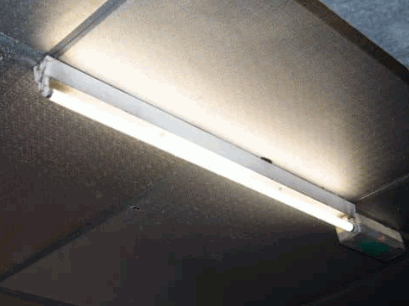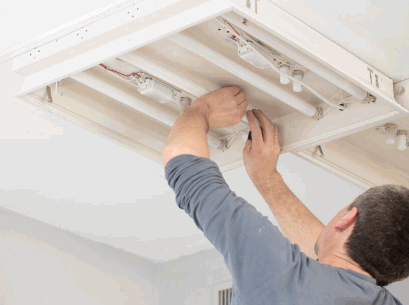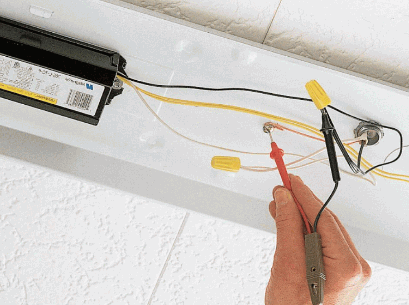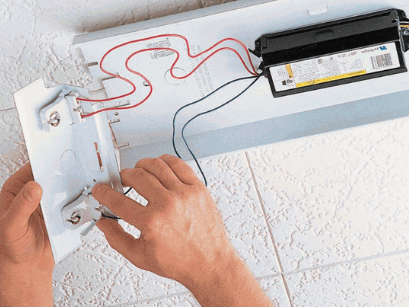Table Of Contents
Curious about how to upgrade your fluorescent lighting to LED?
We explore the benefits of retrofitting, including energy efficiency, cost savings, and longer lifespan.
Find a step-by-step guide on how to retrofit fluorescent to LED, from determining the right fixture to installing the LED replacement.
Important factors to consider before retrofitting are compatibility and color temperature.
Discover the advantages of making the switch to LED lighting.

What Is Retrofitting?
Retrofitting refers to the process of updating or replacing outdated systems with newer, more efficient technologies. In the context of lighting, retrofitting involves converting existing fluorescent fixtures to LED technology for improved performance and energy savings.
This upgrade not only enhances the quality of light output but also significantly reduces energy consumption. LED lighting is known for its longevity and durability, making it a sustainable solution for various settings. By replacing traditional fluorescent lights with advanced LED fixtures, businesses can create a more environmentally friendly workspace while simultaneously lowering electricity costs. Additionally, LED retrofitting often qualifies for energy efficiency rebates or incentives, encouraging companies to make the switch and further offset initial investment costs.

Why Retrofit Fluorescent To LED?
Retrofitting fluorescent lighting to LED offers numerous advantages, including energy efficiency, cost savings, and a longer lifespan. LED technology provides a more sustainable and cost-effective lighting solution compared to traditional fluorescent fixtures, especially in T8 fixtures.
LED lighting consumes significantly less energy than fluorescent lighting, leading to reduced electricity bills and a lower carbon footprint. Plus the energy savings, LED fixtures have a longer lifespan, thus reducing maintenance costs and the frequency of replacements. This switch not only benefits your wallet but also the environment, as less energy consumption means decreased greenhouse gas emissions. LED technology offers superior light quality, better color rendering, and improved flexibility in terms of customization and control, making it a smart choice for businesses and residential settings alike.
Check out: Are LED Ceiling Lights Any Good
Energy Efficiency
One of the primary benefits of retrofitting fluorescent to LED is the significant improvement in energy efficiency. LED technology consumes less electricity, resulting in lower energy costs and higher energy savings for both residential and commercial properties.
LED lighting is not only energy-efficient but also environmentally friendly. By using LED tubes for lighting solutions, one can decrease their carbon footprint and contribute to a greener planet. LED lights have a longer lifespan compared to traditional lighting options, which means fewer replacements and maintenance costs in the long run.
Cost Savings
Switching from fluorescent to LED lighting can result in substantial cost savings over time. LED retrofit kits, such as those offered by Magnilumen, provide an efficient and cost-effective way to replace traditional lighting fixtures while reducing maintenance and energy costs.
LED technology is known for its longevity, with LED bulbs lasting significantly longer than traditional fluorescent lights. This extended lifespan translates into reduced replacement and maintenance expenses, further contributing to the overall cost-effectiveness of LED retrofits. LED lighting is energy-efficient, consuming less power than fluorescent options, leading to lower electricity bills in the long run. By opting for retrofit kits like those from Magnilumen, businesses can seamlessly upgrade their lighting systems without the need for complete fixture replacements, saving both time and money.
Longer Lifespan
LED lighting systems have a significantly longer lifespan compared to fluorescent fixtures, translating to reduced maintenance costs and a lower frequency of replacements.
The longevity of LED fixtures is a game-changer in the realm of lighting technology. With an average lifespan of over 50,000 hours, LED lights outlast traditional fluorescent options by a vast margin. This extended durability not only diminishes the need for frequent replacements but also minimizes the maintenance required. As a result, businesses and homeowners benefit from reduced costs and disruptions due to fewer breakdowns and replacements.

How To Retrofit Fluorescent To LED?
The process of retrofitting fluorescent to LED involves several key steps, starting with identifying the type of fluorescent fixture and selecting the appropriate LED replacement. Installing the new LED fixture requires removing the old fluorescent bulbs, connecting the wiring, and testing the setup for optimal performance.
Once you have identified the type of fluorescent fixtures, such as T8 fixtures, you can choose a suitable LED replacement that fits the existing housing.
In terms of wiring, ensure that the power source is turned off before beginning the installation process to avoid any electrical hazards.
Cost-effective retrofitting options include retrofit kits that make the conversion process smoother and more affordable.
By following these steps meticulously, you can upgrade your lighting system from fluorescent to LED efficiently and enjoy the benefits of energy efficiency and longevity.

Determine The Type Of Fluorescent Fixture
Before initiating the retrofitting process, it is crucial to identify the specific type of fluorescent fixture in use. Different fixtures may require distinct LED conversion kits or retrofit solutions to ensure compatibility and optimal performance.
For instance, there are various types of fluorescent fixtures commonly found in commercial and residential settings, including T8, T12, and compact fluorescent fixtures. Each of these fixtures has unique specifications and wiring configurations that necessitate a customized approach to LED conversion.
Assessing the existing fixture is essential as it determines the type of LED retrofit kit required for a seamless installation process. Choosing the wrong kit can lead to compatibility issues, inefficient lighting, and potential safety hazards.
Choose The Right LED Replacement
Selecting the appropriate LED replacement for the existing fluorescent tubes is crucial for a successful retrofitting project. Consider factors such as compatibility, lifespan, and energy efficiency when choosing between T8 LED and T8 fluorescent options.
When comparing T8 LED and T8 fluorescent options, one key factor to consider is compatibility. While T8 fluorescents can be a direct replacement for existing T8 fixtures, T8 LED tubes might require additional considerations due to their electronic components. T8 LED tubes typically offer a longer lifespan compared to T8 fluorescents, thus reducing maintenance costs and the frequency of replacements over time.
Additionally, energy efficiency plays a crucial role in the decision-making process. T8 LED tubes are known for their low energy consumption, making them an environmentally friendly choice that can lead to significant cost savings on electricity bills. On the other hand, T8 fluorescents tend to consume more power, resulting in higher energy costs in the long run.
Remove The Fluorescent Bulbs
To begin the retrofit process, carefully remove the existing fluorescent bulbs from the fixture. Ensure proper handling and disposal of the old tubes before proceeding with the installation of LED replacements, considering the available options for tube conversion.
When handling fluorescent bulbs, it is vital to take precautions to avoid breakage and exposure to harmful toxins such as mercury. Use protective gloves and eyewear to safely unscrew the tubes from the fixture.
Proper disposal is crucial; gather the old tubes in a sealed container or wrap them in newspaper before dropping them off at designated recycling centers. Alternatively, for an eco-conscious approach, consider converting the fixtures to LED tubes instead of disposing of the fluorescent ones.

Install The LED Replacement
After removing the fluorescent bulbs, proceed to install the LED replacements using retrofit kits designed for quick and efficient conversion. Ensure proper alignment and fit of the LED bulbs, especially in T8 fixtures, to guarantee optimal light output and energy efficiency.
LED replacements offer numerous advantages over traditional fluorescent bulbs when used in T8 fixtures. The installation process is straightforward and can be completed without any professional assistance. LED bulbs are known for their energy efficiency, longer lifespan, and superior brightness, making them an ideal choice for both residential and commercial settings. By aligning the LED bulbs correctly within the fixtures, users can enjoy consistent and uniform illumination throughout the space, resulting in enhanced visibility and reduced energy consumption.

Connect The Wiring
Connecting the wiring for the new LED fixtures is a straightforward process, typically involving matching the socket connections and securing the wiring for a reliable electrical connection. Ensure the wiring is done correctly for easy integration of LED lighting solutions.
When connecting the wiring for LED retrofitting, double-checking that the socket types match is crucial for compatibility. Ensuring a firm and secure connection between the wiring and the sockets is essential to avoid flickering or other performance issues. Always follow the manufacturer's recommendations and guidelines to guarantee a smooth installation process. This attention to detail in the wiring process not only ensures optimal performance but also contributes to the overall safety of the lighting system.

Test And Adjust
Once the LED replacements are installed and wired, it is essential to test the lighting setup to ensure proper functionality and performance. Make any necessary adjustments or modifications for optimal illumination, especially in traditional fixtures like 4ft fluorescent tubes.
Testing the LED retrofit installations is a crucial step to guarantee that the lighting is functioning as intended. To do this effectively, start by illuminating the area and observing the light output and distribution. Check for any flickering, dimming, or uneven lighting patterns that may indicate a problem.
If you encounter issues with the 4ft fluorescent tubes that have been converted, ensure that the LED replacements are securely in place and wired correctly. Adjust the position of the LEDs if needed to improve the overall brightness and consistency of the lighting.
It is also recommended to compare the new LED lighting with existing fixtures to determine if any adjustments are required for uniformity. By carefully testing and adjusting the installation, you can achieve optimal performance and lighting quality in your space.
What Are The Things To Consider Before Retrofitting?
Before embarking on a retrofitting project, it is essential to consider factors such as fixture compatibility, color temperature preferences, lumens output, and wattage requirements. These considerations ensure a successful transition from fluorescent to LED lighting.
Fixture compatibility is crucial, as LED bulbs come in various shapes and sizes, requiring compatible fixtures to function efficiently.
When selecting color temperature preferences, consider whether you prefer a warmer or cooler light tone to suit the ambiance.
Determining the necessary lumens output ensures proper brightness levels for the specific area being illuminated while gauging the adequate wattage requirements is essential for energy efficiency and cost-effectiveness.
Compatibility
When planning a retrofit from fluorescent to LED, ensuring compatibility between the existing fixtures and the new LED solutions is crucial. Verify that the sockets, wiring, and mounting options align to facilitate a smooth installation process without compatibility issues.
Socket compatibility plays a vital role, as different types of sockets may be required for LED replacements. It is essential to confirm that the sockets in the current fixtures are suitable for the new LED bulbs.
Checking the wiring alignment is key to avoid any electrical issues during installation. Ensuring that the wiring can support the power requirements of the LED bulbs is essential for proper functioning.
Examining the mounting options is equally important, as LED fixtures may have different mounting mechanisms. Ensuring that the existing fixtures can accommodate the new mounting styles can prevent complications during the installation process.
Color Temperature
Selecting the appropriate color temperature for LED replacements is essential for achieving the desired lighting ambiance and visual comfort. Consider factors like lumens output and wattage equivalents to match the color temperature preferences during the retrofit process.
Color temperature plays a crucial role in setting the mood and overall feel of a space. Warm white tones, around 2700-3000K, create a cozy and inviting atmosphere perfect for residential areas like living rooms and bedrooms. On the other hand, cool white tones, approximately 4000-5000K, are ideal for task-oriented spaces such as offices and kitchens, providing a bright and stimulating environment.
When upgrading to LED lighting, it's important to balance the lumens output to ensure sufficient brightness without causing glare or discomfort. Higher lumens correspond to brighter light, so selecting the right output based on the room's size and function is crucial. Similarly, understanding the wattage equivalents of traditional incandescent or fluorescent bulbs can help in choosing energy-efficient LED replacements that maintain the desired brightness levels while reducing energy consumption.
Lumens And Wattage
Understanding the relationship between lumens and wattage is essential when retrofitting to LED lighting. Higher lumens output with lower wattage consumption translates to energy savings and improved lighting performance, making it a key consideration for retrofit projects.
When transitioning to LED lighting, it's crucial to focus on achieving the right balance between brightness and energy efficiency. Opting for bulbs with higher lumens and lower wattage not only results in cost savings over time but also contributes to a more sustainable environment. By selecting bulbs with optimal lumens-to-wattage ratios, users can ensure that they are maximizing the benefits of LED technology while minimizing their energy consumption.

What Are The Benefits Of Retrofitting?
Retrofitting from fluorescent to LED offers a range of benefits, including energy savings, enhanced lighting quality, reduced maintenance costs, and environmental advantages. Upgrading to LED fixtures aligns with energy-efficient practices and contributes to sustainable lighting solutions.
LED lighting systems are known for their remarkable energy efficiency, significantly lowering electricity usage and utility bills while lasting much longer than traditional lighting sources. The improved illumination from LED technology provides a more vibrant and visually appealing environment, enhancing productivity and comfort for individuals in various settings. The long lifespan of LEDs reduces the frequency of replacements, diminishing maintenance expenses over time.
Transitioning to LED not only brings about financial benefits but also has a positive impact on the environment. With LED's eco-friendly nature, there is a significant reduction in energy consumption, lessening carbon footprints and helping create a more sustainable future. By embracing LED lighting solutions, businesses and households can play a vital role in promoting greener practices that benefit both the present and future generations.
Energy Savings
One of the primary benefits of retrofitting to LED is the significant energy savings achieved through reduced electricity consumption and extended lamp life. LED retrofit projects may qualify for utility rebates, enhancing the overall cost-effectiveness of the transition.
Reduced energy consumption not only leads to immediate cost savings but also contributes to a more sustainable environment by lowering carbon emissions. The extended lamp life of LEDs minimizes maintenance costs and reduces replacement frequency, resulting in long-term efficiency gains.
Improved Lighting Quality
LED retrofits enhance lighting quality by providing superior brightness and lumen output compared to traditional fluorescent fixtures. Features like ballast bypass options further improve light consistency and performance, offering customizable lighting solutions for various applications.
These retrofits not only increase the overall luminance but also contribute to energy efficiency and reduced maintenance costs, making them a cost-effective lighting solution for businesses and homes alike. The improved illumination provided by LED retrofits creates a more vibrant and welcoming atmosphere in commercial spaces, enhancing productivity and customer experience. With the ability to adjust the light output and color temperature, users can tailor the lighting to suit different settings, whether it's a bright, focused light for retail environments or soft, ambient lighting for hospitality venues.
Reduced Maintenance Costs
Transitioning to LED lighting through retrofit projects reduces maintenance costs by minimizing the frequency of bulb replacements and optimizing the efficiency of lighting systems. Commercial properties can benefit from this cost-effective option while exploring utility rebate paths for additional savings.
LED retrofitting not only decreases the need for constant bulb changes but also enhances the overall performance of the lighting setup, which in turn leads to lower utility bills for commercial buildings. By upgrading to energy-efficient LED technology, businesses can significantly cut down on maintenance expenditures and allocate those funds to other aspects of their operations. Many utility companies offer rebates or incentives to encourage the switch to eco-friendly lighting solutions, providing an extra layer of cost savings for forward-thinking property owners.
Environmental Benefits
Retrofitting to LED contributes to environmental benefits by reducing energy consumption, minimizing waste from discarded fluorescent tubes, and aligning with sustainable lighting goals. Businesses can allocate a portion of their budget to retrofit projects, promoting eco-friendly practices within their premises.
Transitioning to LED lighting not only supports a greener environment but also offers long-term cost savings through lower energy usage and reduced maintenance costs. The durability and longevity of LED lights mean fewer replacements, further cutting down on waste generation.
By investing in LED retrofit initiatives, companies not only enhance their energy efficiency but also showcase their commitment to sustainability. This strategic allocation of resources toward eco-conscious lighting solutions not only benefits the environment but also demonstrates corporate responsibility, setting a positive example for others.


